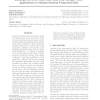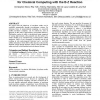111 search results - page 3 / 23 » Organization-Oriented Chemical Programming |
IEEECIT
2010
IEEE
13 years 3 months ago
2010
IEEE
Abstract--Nowadays, novel applications, such as personalized e-commerce services, call for cooperation across enterprise boundaries. Service-Oriented-Architecture (SOA) forms a sol...
ICML
2004
IEEE
14 years 6 months ago
2004
IEEE
Inductive learning of first-order theory based on examples has serious bottleneck in the enormous hypothesis search space needed, making existing learning approaches perform poorl...
GECCO
2007
Springer
13 years 11 months ago
2007
Springer
We propose that the behaviour of non-linear media can be controlled automatically through coevolutionary systems. By extension, forms of unconventional computing, i.e., massively ...
SAINT
2005
IEEE
13 years 11 months ago
2005
IEEE
Inductive Logic Programming (ILP) is a combination of inductive learning and first-order logic aiming to learn first-order hypotheses from training examples. ILP has a serious b...
EVOW
2003
Springer
13 years 10 months ago
2003
Springer
Genetic programming (GP) based data fusion and AdaBoost can both improve in vitro prediction of Cytochrome P450 activity by combining artificial neural networks (ANN). Pharmaceuti...


